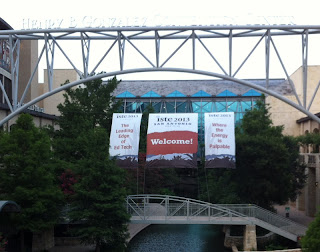International Society for Technology for Education (ISTE) 2013 Conference Dorothy's Top 3 Highlights
 What a blessing it was to have the opportunity to attend the ISTE June 2013 conference in Texas, San Antonio alongside 20,000+ attendees. This was by far the largest conference I have attended to date. Imagine having to stand in Disneyland-type lines to enter the keynote presentation hall that could accommodate thousands and thousands of people. Not having attended an ISTE conference since 2005, it was such a refreshing, inspirational, reflective, and enjoyable experience for me.
What a blessing it was to have the opportunity to attend the ISTE June 2013 conference in Texas, San Antonio alongside 20,000+ attendees. This was by far the largest conference I have attended to date. Imagine having to stand in Disneyland-type lines to enter the keynote presentation hall that could accommodate thousands and thousands of people. Not having attended an ISTE conference since 2005, it was such a refreshing, inspirational, reflective, and enjoyable experience for me.My top 3 highlights of the conference included:
- Adam Bellow's closing keynote titled "You're Invited to Change the World" (begins approximately at 23 minutes): His keynote was my favorite at the conference. Not only were his slide deck an exemplar model of instructional design practices, his method of delivery appealed to diverse learning styles and inspired all types of audiences to change the world through educational technology. I especially enjoyed how he started his keynote with his experience at ISTE through his Google Glass and his sharing of numerous relevant personal stories throughout his keynote that showcased innovative and practical application of educating today's learners. This archived keynote is definitely worth your time.
- Game-Based Learning: I attended many sessions surrounding the topic of game-based learning trying to wrap my head around what the most current trends are along with samples within a K-12 environment. Minecraft and Angry Birds seemed to be fairly popular games in secondary education. One of Harvard's grant custom created virtual environments for middle school students revolving around ecosystems was an interesting project, http://ecomuve.gse.harvard.edu/. Another session provided this game analysis checklist resource by Andrew Miller, which I felt was a helpful guide for those diving into creating game-based learning.
- Mobile Learning & Augmenting in the Classroom: QR codes were everywhere, especially as you visited the poster sessions. As I sat in various mobile learning sessions, there were many ideas and working samples provided by presenters (various uses of QR code activities in the classroom, creating vocabulary word walls for various topics, student presentation visuals created and placed around the room with embedded videos that students could provide peer to peer feedback, creating museum and other living history tours, interactive yearbook with interviews, etc.). These ideas inspired me to create an activity for our team upon my return from the conference so I could inspire them to integrate meaningful experiences for our blended and online learners. Aurasma seemed to be the most popular app of choice at the moment followed by QR code readers.
There were so many ideas spinning in my head, even 2 months after attending the conference. After reviewing all my session notes and various archived session recordings, I zoned in on the following next steps to implement what I have learned through this valuable professional development experience.
- Mobile learning - During development of new projects by our team, I will be encouraging everyone to keep mobile learning at the forefront of their minds, not only simply providing mobile accessibility to the cultural content we develop, but also brainstorming meaningful instructional strategies in which we could implement relevant and impactful experiences for our Hawaiian learners.
- Augmented learning - I will develop a culture-based augmented learning activity to integrate into our team meeting that will both model and encourage them to think of innovative solutions to engage our online learners.
- Game-based learning - I will be sharing what I have learned related to game-based learning and brainstorm how beneficial this could be if/when integrated strategicallinto our online programs and support services projects. One of our Tri-Campus teachers indicated interest in moving in this area and I look forward to supporting that.
- I will continue to keep student learning outcomes and experiences as the forefront driver of the projects we work on, especially with so many new technologies emerging in the educational technology market...testing a wide range of technologies, but only selecting those that will integrate seamlessly and truly enhance student learning in blended and online environments.





Comments